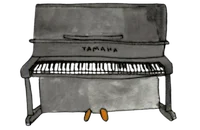Upright Piano Safety Castors Comparison - which are best"
Here we take a quick look at the various options available for installing safety castors to an upright piano to help prevent it being accidentally pushed over by untrained people in schools, colleges, venues, etc. If you leave the original tiny brass castors on, a piano can be very easily pushed over onto its back by mistake which carries a very high risk of serious injury or death. So please take your time to choose the best option for you.
1. The worst option – do nothing
The worst option is to do nothing and risk leaving the original tiny brass castors on. They can easily dig into the floor whilst being pushed sending the piano flying onto its back in the blink of an eye without any warning. Not recommended
Pros:- Maintains original wheels
- That’s it :/
- High risk of death or injury if the piano is ever moved by anyone untrained
- Will ruin your floor if you move the piano

2. Next best option – easy-rolling twin-rubber castors
These are much better than the existing brass castors. They are bigger and roll very easily which means they will cope with little bumps on the ground without wanting to flip the piano onto its back quite so easily. The only downside is that they make it very easy to push the piano very fast, and that extra speed means the risk of it being pushed over onto its back is increased. So whilst this option is an improvement, I don’t think it offers full piece of mind. Proceed with caution
Pros- Nice and easy to roll
- Won’t damage flooring
- If you take it slow, the risk of anything going wrong is very minimal
- Feel like Jeff Capes pushing a piano so easily
- Piano sits slightly higher than normal making pedalling slightly more awkward
- Slightly higher centre of balance

The best 2 options…
See below for the best 2 options, in no particular order
3. Good option 1: Rear toe kit
The huge benefit of having this rear toe kit sticking out of the back of piano is that it significantly lowers the centre of balance making it much harder to accidentally knock the piano over backwards. You stick this on the back, you replace the front castors with easy-rolling rubber castors and you now have a piano that is generally safe to be carefully moved around.
The very slight shame (and it is only a relatively minor point) is that the castors are larger than the brass castors so the piano sits a bit higher than normal which means (a) pedalling is slightly more awkward and (b) the centre of balance is higher than if the wheels were the same size as the original brass castors.
If the piano will be occasionally moved by careful people, this option is fine. If it will be moved by hyperactive gorillas then it may still carry some risk of being accidentally pushed over backwards.
Oh and as it sticks out at the back you can’t push the piano flush against a wall which might bug you.
Pros:- Easy to fit
- Fast rolling
- Lowers the centre of balance nicely
- Piano sits slightly higher than normal making pedalling slightly more awkward
- Piano can’t be pushed flush back against a wall. It will stick out a few inches.
It’s a solid option overall.

4. Good option 2: Upright piano safety bracket with castors (needs a better product name!)
We don’t really enjoy fitting these as there is always a slight risk that the bracket might scratch someone’s posh wooden flooring of a brand new concert hall. That’s because the bracket is screwed to the underside of the piano which is already very close to the floor. It leaves very little clearance once the bracket is installed. The one strong advantage of them is that because the piano sits cradled in the bracket, it means that the piano is not raised up any higher compared with the original small brass castors. That means the pedalling is unaffected and it means the centre of balance is extremely low. So this option is great apart from a bit of apprehension on our part that it might rip a hole in the lovely new £1m Karndean flooring of your new performance space.

Conclusion?
Hmmm. Tricky. Option 3 (rear toe kit) has the least chance of something going wrong in terms of fitting and suitable for your space. It’s fool proof. Option 4 (bracket) has the added benefit of keeping the piano low to the ground but that also introduces a risk of the bracket occasionally damaging the floor. The final decision is yours! :)










